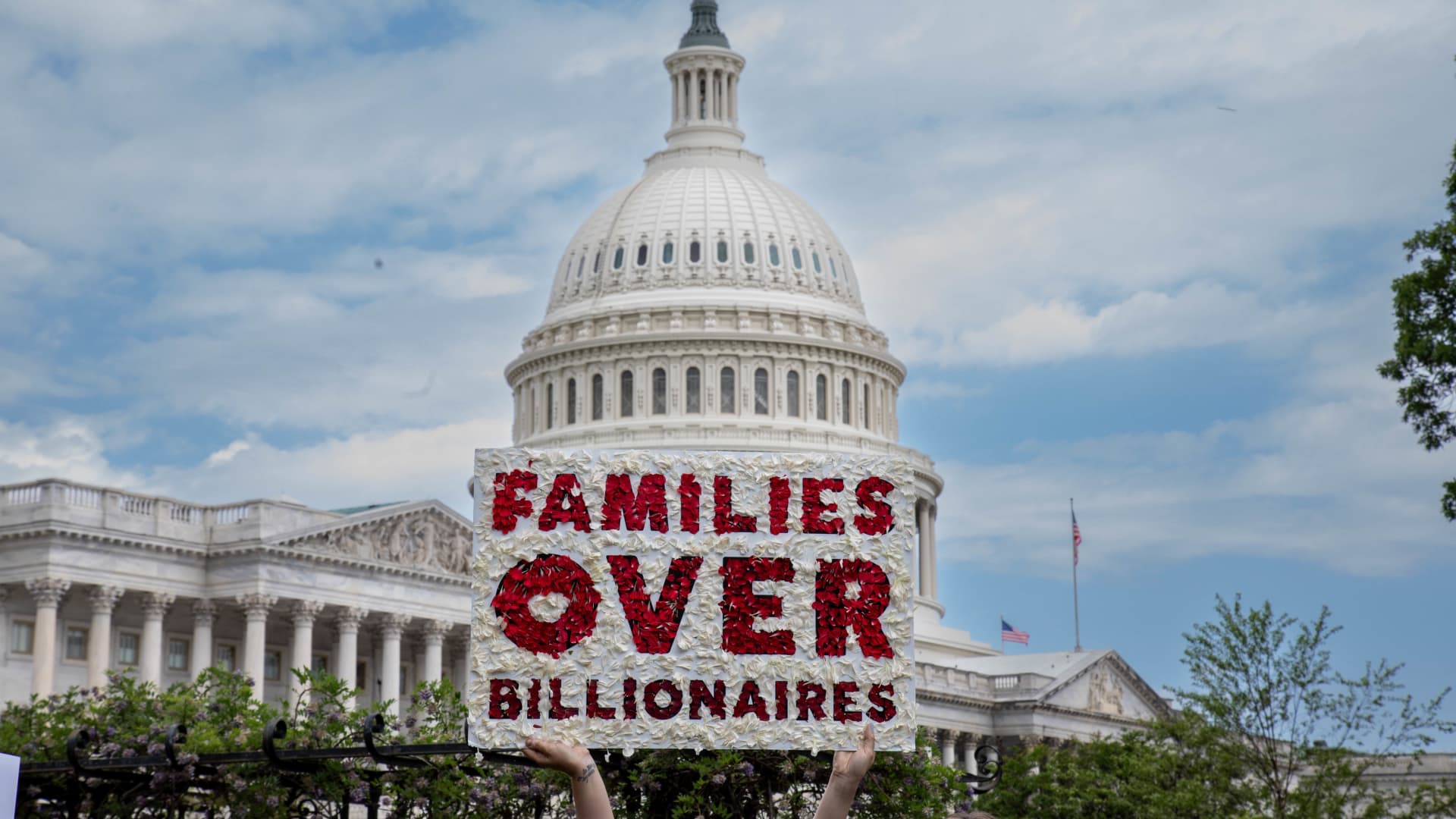People walk by a sign for Freddie Mac headquarters on July 14, 2008 in McLean, Virginia. AFP Photo/Paul J. Richards (Photo credit should read PAUL J. RICHARDS/AFP via Getty Images)
Paul J. Richards | Afp | Getty Images
Fannie Mae and Freddie Mac — the two giant mortgage finance firms controlled by the federal government for nearly 17 years — could be sold off into the private sector.
During President Donald Trump’s first term, the White House attempted to release the Federal National Mortgage Association, known as Fannie Mae, and the Federal Home Loan Mortgage Corporation, known as Freddie Mac, into the private market. It didn’t materialize because of the complexity, according to experts.
While Trump hasn’t talked about the idea to sell off the government’s shares into the private market, the topic is bubbling up now in Trump’s second term. It could lead to higher mortgage rates and risk for investors, experts warn.
In January, the Federal Housing Finance Agency and the Treasury Department agreed to amend the senior preferred stock purchase agreements between the Treasury and and Fannie Mae and Freddie Mac, each government-sponsored enterprises, to ensure their eventual release from conservatorship.
What problem are we trying to fix?
Mark Zandi
chief economist at Moody’s Analytics
Experts are torn about how the release of the GSEs will be handled, when it will happen and if the government will continue to somewhat oversee the mortgage giants after-the-fact.
Ultimately, the release from the government-backing for Fannie Mae and Freddie Mac’s will come down to what Trump prioritizes during his second term. And even then, there could be drawbacks, experts say.
“It really ultimately depends on what President Trump wants to do or not do,” said Mark Zandi, chief economist at Moody’s Analytics.
“Even then though, I think they’ll be repelled from actually getting it done because the economics will become apparent that this makes no sense,” Zandi added.
Here’s what to know.
What the release could mean for homebuyers, investors
The potential impact will depend on the extent of the government’s support after Fannie Mae and Freddie Mac are released, according to Andy Winkler, director of housing and infrastructure projects at the Bipartisan Policy Center.
The Trump administration’s ability to navigate logistical, legal and economic hurdles will also be a factor, experts say.
But “a lot could go wrong,” said Susan Wachter, professor of real estate and professor of finance at The Wharton School of the University of Pennsylvania.
If not done well, mortgage rates could potentially climb higher, experts say. Zandi believes “it’s just a question of how much higher” rates would be.
It’s not something you can do with one signature on one agreement.
Susan Wachter
professor of real estate and professor of finance at The Wharton School of the University of Pennsylvania
If you invest in mortgage-backed securities or in Fannie Mae or Freddie Mac’s secured debt, the end of the conservatorship could bring on more risk, Zandi said.
“Therefore you will demand a higher interest rate to compensate for that risk, and therefore mortgage rates will be higher as well,” Zandi said.
Of course, higher rates means higher borrowing costs for mortgages.
While more people bought their homes in all-cash payments in 2024, most Americans still rely on mortgages to buy properties.
According to a report by the National Association of Realtors, about 26% of homebuyers in the U.S. paid all-cash in 2024, a new high for the segment. To compare, the last record increase was 22% in 2022, up 9% from 2021, per data provided to CNBC.
However, roughly 74% of buyers financed their home purchase in 2024, NAR found. That’s down from 80% a year prior.
In Zandi’s view, any release scenario could affect all parties involved – except potentially Fannie and Freddie shareholders.
“They’re going to make money on the shares they own … That’s why they’re pushing for it,” he said.
Why Fannie Mae and Freddie Mac are essential
Fannie Mae and Freddie Mac buy existing home loans from mortgage lenders. The companies either keep or sell the loans as mortgage-backed securities to investors, creating a system where mortgage lenders have enough capital to continue offering loans.
“The 30-year fixed rate mortgage might not exist without them,” said Bipartisan Policy Center’s Winkler.
The two companies support around 70% of the mortgage market and remain vital to the housing system in the U.S., according to NAR.
The two were created by Congress in order to make homeownership accessible and make the 30-year fixed rate mortgage “the bread and butter” of the U.S., Zandi said.
More from Personal Finance:
Wholesale egg prices have ‘blown way past’ record highs
2025 could be a renter’s market — but it won’t last
Here’s the average tax refund so far this year
Fannie Mae and Freddie Mac have been under a conservatorship with the FHFA since 2008, after the mortgage giants nearly collapsed during the financial crisis. The agreement was done to help the two government-sponsored enterprises recover from the housing market crash.
The Department of the Treasury has financially supported the two companies through senior preferred stock purchase agreements, or SPSPAs, helping them remain solvent.
The mortgages that were being created leading up to the financial crisis were complex, risky, and untraced, Wachter said. The risk was able to build up overtime.
To be sure, such risky loans were coming from the private sector’s private label mortgage-backed securities, she said. When the market imploded, causing trillions of dollars worth of lending to evaporate within a year, the GSEs were caught in the crossfires.
“The private-label mortgage-backed securities, risky loans, brought on the crisis, but every mortgage player was hit,” Wachter said.
With Fannie and Freddie being the two largest mortgage institutions, the government intervened and bailed the enterprises in 2008 to avoid further damage to the housing market.
Fannie and Freddie became explicitly backed by the government and steps were taken to de-risk them as well as limit the exposure to taxpayers under the conservatorship, Winkler said.
Under government control, the GSEs don’t operate as fully private companies: they have limited ability to retain profits, strict oversight and a primary goal to maintain the housing market stable over maximizing profits, he said.
What are the odds of the conservatorship ending?
While Trump himself has yet to mention the conservatorship, others are talking about it.
Scott Turner, the new secretary of Housing and Urban Development, mentioned in an interview published on Feb. 5 with the Wall Street Journal that making the effort to release Fannie and Freddie would be a priority.
Pershing Square CEO Bill Ackman posted on X in December that “a successful emergence from Fannie and Freddie should generate $300 billion of additional profits to the government” while removing about $8 trillion of liabilities from the government’s balance sheet.
Even if the administration prioritizes the conservatorship, the process itself could take years to complete, experts say.
“It’s not something you can do with one signature on one agreement,” Wachter said. The process involves multiple parties, including the Treasury, the Department of Justice, FHFA and shareholders in the private sector.
However, if “based on the economics of it all, there should be no chance that they get released administratively,” Zandi said. “It doesn’t make any economic sense.”
“A release is a lose-lose for taxpayers, homebuyers, the housing market, the economy, everybody is worse off than the status quo.” Zandi said. “What problem are we trying to fix?”


 Economics1 week ago
Economics1 week ago
 Economics1 week ago
Economics1 week ago
 Economics7 days ago
Economics7 days ago
 Finance1 week ago
Finance1 week ago
 Blog Post1 week ago
Blog Post1 week ago
 Economics1 week ago
Economics1 week ago
 Personal Finance7 days ago
Personal Finance7 days ago
 Economics1 week ago
Economics1 week ago













